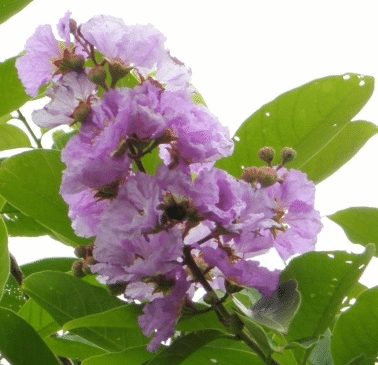A Hawaii Artist discovers beauty and more in Island Sourced Materials!
- Amy Christmas

- Nov 24, 2020
- 2 min read
Updated: Jun 18, 2021
Kahili Flower, Giant Crape Myrtle-Lagerstroemia speciosa
4 things you may not know about this Kauai plant

1. What is it? Kahili Flower is a member of the loosestrife family, which the well known Cigar flower used in lei is also a member. Crape Myrtle is a small-medium sized deciduous evergreen tree. It is prevalent in cool upland areas and prefers full sun. The name Crape Myrtle is derived from the flowers of the tree which look very similar to crinkled crepe paper. The 6-8 petal flowers are exceptionally showy covering the entire tree for several weeks, and range in color from a lavender to beautifully rich magenta purple. Hundreds of flowers are arranged in erect multi-branched panicles averaging 7 1/2-16" long looking quite similar to a Hawaiian feather kahili. The Kahili Flower tree flowers twice a year here and is followed by round seed pod capsules. The capsule matures over several months, and eventually splits open into 7 sections, and releases numerous small winged seeds. The tree itself is rather coarse in appearance, and messy when the leaves drop after flowering. The new shoots are attractive due to their redish purple tinge and in some other regions it has a yellow fall color, giving it a few added reasons to be used as an ornamental.
2. Where did it come from? Native to subtropical and tropical India it was introduced to Hawaii by Dr. William Hillebrand in the early 1900's. His tree still stands near the Main Terrace, of the Foster Botanical Garden in Oahu and is considered the largest in the U.S. In the Philippines, Taiwan, and Japan, the leaves are used as herbal tea. In Vietnam, young leaves are eaten as a vegetable, and older leaves and fruit are used medicinally to reduce glucose in blood. The seeds also have been said to have narcotic properties. In one form of Buddhism, this plant was symbolic of achieved enlightenment.
3. When is the best time for collecting? We collect the seed pods 2 times a year after they have opened up. They are at top of the tree at the very tips of the branches and have to be cut with a long pruner. If not pruned off, the seed pods start to degrade and eventually are blown off in the wind and rain. We like to get them before they have weathered too much to preserve the quality. They store well in the open air and require no additional care when used on any of our products.

4. How are the collected plant parts used?
The seed pods can be used in a potpourri, or a dried arrangement. We use them in clusters as a primary adornment at the very front of a basket or pouch, as a dried flower on the Hawaiian Tree Topper Angel wreath and as her hair flower. Additionally, we used a single piece of the pod to represent a bowl on our Kauai Mahi’ai (farmer) Angel ornament.
*Amy is a University of Hawaii Certified Master Gardener Emeritus, has a Bachelor of Science-Landscape Horticulture degree from Ohio State, has been a volunteer tour guide at NTBG, and is a self-proclaimed "plant nut"! She and her husband Ron have been making and selling their baskets for more than 20 years.




























Comments